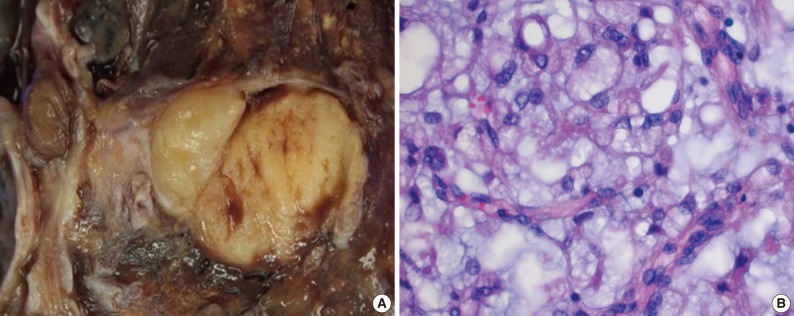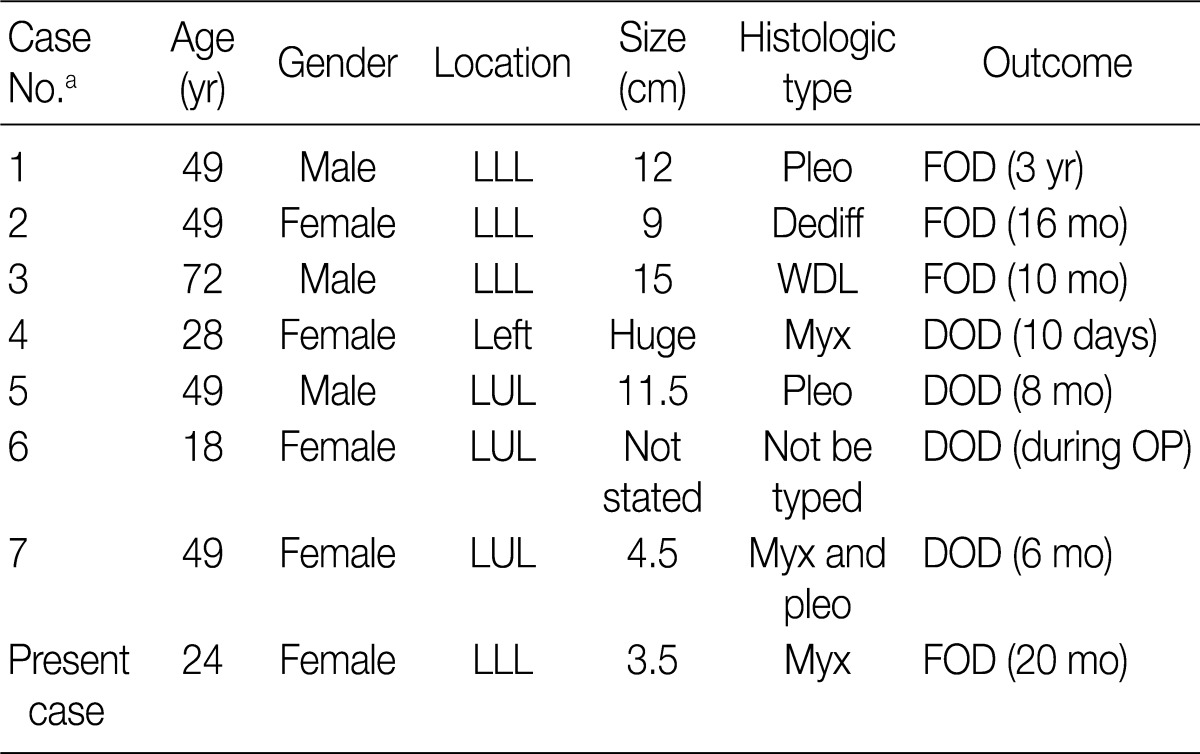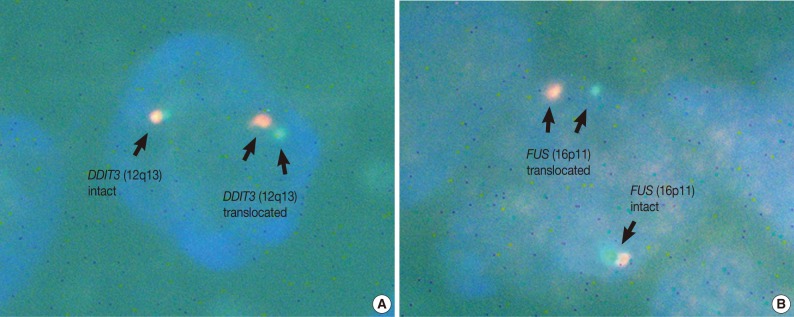Articles
- Page Path
- HOME > J Pathol Transl Med > Volume 46(4); 2012 > Article
-
Case Report
Primary Pulmonary Myxoid Liposarcoma with Translocation t(12;16)(q13;p11) in a Young Female Patient: A Brief Case Report - Choonhee Son, Phil Jo Choi1, Mee Sook Roh2
-
Korean Journal of Pathology 2012;46(4):392-394.
DOI: https://doi.org/10.4132/KoreanJPathol.2012.46.4.392
Published online: August 23, 2012
Department of Internal Medicine, Dong-A University College of Medicine, Busan, Korea.
1Department of Thoracic and Cardiovascular Surgery, Dong-A University College of Medicine, Busan, Korea.
2Department of Pathology, Dong-A University College of Medicine, Busan, Korea.
- Corresponding Author: Mee Sook Roh, M.D. Department of Pathology, Dong-A University College of Medicine, 32 Daesingongwon-ro, Seo-gu, Busan 602-714, Korea. Tel: +82-51-240-2833, Fax: +82-51-243-7396, msroh@dau.ac.kr
© 2012 The Korean Society of Pathologists/The Korean Society for Cytopathology
This is an Open Access article distributed under the terms of the Creative Commons Attribution Non-Commercial License (http://creativecommons.org/licenses/by-nc/3.0) which permits unrestricted non-commercial use, distribution, and reproduction in any medium, provided the original work is properly cited.
Abstract
- Primary liposarcoma of the lung is an extremely rare disease. To date, only 14 cases have been reported in the literature. We experienced a case of myxoid liposarcoma of the lung treated by surgery. The tumor was well-defined, solid, lobulated mass measuring 3.5×2 cm, involving the bronchus of the left lower lobe. Microscopically, myxoid liposarcoma was identified. The fluorescence in situ hybridization confirmed the presence of a reciprocal translocation involving DNA damage-inducible transcript 3 (DDIT3) and fused in sarcoma (FUS) genes. The patient is still alive with no recurrence or metastasis at the time of writing this report (on 20 months postoperatively). To our knowledge, this is the first cytogenetic case report of pulmonary myxoid liposarcoma.
- A 24-year-old woman was referred to Dong-A University Medical Center following the detection of a well-defined mass in the left lower lobe (LLL) of the lung on chest X-ray during a routine health check. On medical and family history, the patient had no notable findings other than a 6-month history of an intermittent dry cough. On chest computed tomography (CT) scan, the patient had a lobulated, well-enhancing mass with an endobronchial protrusion in the LLL. On positron emission tomography-CT scans, the patient had no notable findings of other organs. The patient underwent a bronchoscopy, but a diagnosis could not be made on biopsy. A left lower lobectomy with regional lymph node dissection was performed. The tumor was a well-defined, solid, lobulated mass measuring 3.5×2 cm, involving the bronchus of the LLL (Fig. 1A). Microscopically, the lesion was a multinodular mass composed of bland fusiform or round cells in a myxoid background with a delicate plexiform capillary vascular network. The tumor cells showed a lipoblastic differentiation of multivacuolar and univacuolar cells (Fig. 1B). Partly, there were sheets of primitive round cells with a high nuclear/cytoplasmic ratio. On immunohistochemistry, the tumor expressed vimentin and S-100 protein. Nineteen dissected regional lymph nodes were negative for metastasis. The fluorescence in situ hybridization specific for the t(12;16)(q13; p11) using DNA damage-inducible transcript 3 (DDIT3) and fused in sarcoma (FUS) break-apart probes (Vysis/Abbot Molecular, Downers Grove, IL, USA) was successfully performed, which confirmed the presence of a reciprocal translocation involving DDIT3 and FUS genes (Fig. 2). The patient is still alive with no recurrence or metastasis at the time of writing this report (on 20 months postoperatively).
CASE REPORT
- To date, a total of 14 cases of primary liposarcoma of the lung have been reported in the literature. But only seven articles were available when the PubMed and KoreaMed searches were conducted for English- and Korean-language articles.1-7 Clinicopathologic features reported in the literature are summarized in Table 1. The patient in our case report is the second youngest one that has been reported and presented to have the smallest tumor mass (3.5 cm). Of note, all the tumors have been reported to involve the left lung. Our case supports the view that a wide surgical excision may be effective in treating primary liposarcoma of the lung. But no specific conclusions can be drawn due to the limited number of reported cases.
- Nearly all the myxoid/round cell liposarcomas are characterized by a reciprocal translocation between the chromosomes 12 and 16, t(12;16)(q13;p11). This translocation leads to the generation of a DDIT3/FUS hybrid protein, which has the ability to cause deregulation of other target genes, to interfere with terminal differentiation of various cells and to down-regulate programmed cell death. It appears to play a direct role in oncogenesis of myxoid liposarcoma.8 However, there is no correlation between DDIT3/FUS fusion type and grade or disease-specific survival.8 In our case, there was a reciprocal translocation involving DDIT3 and FUS. This suggests a central role of these fusion transcripts in the pathogenesis of pulmonary myxoid liposarcoma like the same tumor occurring in other sites.
- To our knowledge, this is the first cytogenetic case report of pulmonary myxoid liposarcoma.
DISCUSSION
Acknowledgments
Acknowledgments
- 1. Achir A, Ouadnouni Y, Smahi M, Bouchikh M, Msougar Y, Benosman A. Primary pulmonary liposarcoma: a case report. Thorac Cardiovasc Surg 2009; 57: 119-120. ArticlePubMed
- 2. Loddenkemper C, Pérez-Canto A, Leschber G, Stein H. Primary dedifferentiated liposarcoma of the lung. Histopathology 2005; 46: 710-712. ArticlePubMed
- 3. Kim SW, Shim YM, Kim J, Kim K, Choi YS, Ahn GH. Surgery for primary pulmonary liposarcoma. Korean J Thorac Cardiovasc Surg 2004; 37: 942-945.
- 4. Said M, Migaw H, Hafsa C, et al. Imaging features of primary pulmonary liposarcoma. Australas Radiol 2003; 47: 313-317. ArticlePubMedPDF
- 5. Krygier G, Amado A, Salisbury S, Fernandez I, Maedo N, Vazquez T. Primary lung liposarcoma. Lung Cancer 1997; 17: 271-275. ArticlePubMed
- 6. Ruiz-Palomo F, Calleja JL, Fogue L. Primary liposarcoma of the lung in a young woman. Thorax 1990; 45: 298-299. ArticlePubMedPMC
- 7. Sawamura K, Hashimoto T, Nanjo S, et al. Primary liposarcoma of the lung: report of a case. J Surg Oncol 1982; 19: 243-246. ArticlePubMed
- 8. Knight JC, Renwick PJ, Dal Cin P, Van den Berghe H, Fletcher CD. Translocation t(12;16)(q13;p11) in myxoid liposarcoma and round cell liposarcoma: molecular and cytogenetic analysis. Cancer Res 1995; 55: 24-27. PubMed
REFERENCES


Figure & Data
References
Citations

- Primary Liposarcoma of the Spleen: Case Report With Review of the Literature
Elisa M. Wächtershäuser, Gabriele Köhler, Verena Böhmer, Alexander Marx, Achim Hellinger
International Journal of Surgical Pathology.2025; 33(4): 928. CrossRef - Primary intrathoracic liposarcomas: A clinicopathologic and molecular study of 43 cases in one of the largest medical centers of China
You Xie, Wenyi Jing, Wei Zhao, Ran Peng, Min Chen, Ting Lan, Heng Peng, Xin He, Huijiao Chen, Zhang Zhang, Hongying Zhang
Frontiers in Oncology.2022;[Epub] CrossRef - Primary Pulmonary Liposarcoma with Pancreatic Metastasis: A Rarest of Rare Intrathoracic Malignancy
Anirban Halder, Rituparna Biswas, Sujit Shukla, Nisha Rana, Vikas Yadav, Jaspreet Kaur
Indian Journal of Medical and Paediatric Oncology.2020; 41(04): 605. CrossRef - Primary dedifferentiated liposarcoma of the lung with rhabdomyoblastic and chrondroblastic differentiation
Anthony Longano, Alexandra DuGuesclin, Catherine Mitchell
Histopathology.2015; 67(6): 923. CrossRef
 PubReader
PubReader-
 Cite this Article
Cite this Article
- Cite this Article
-
- Close
- Download Citation
- Close
- Figure
- Related articles


Fig. 1
Fig. 2

LLL, left lower lobe; Pleo, pleomorphic; FOD, free of disease; Dediff, dedifferentiated; WDL, well-differentiated liposarcoma; Myx, myxoid; DOD, died of disease; LUL, left upper lobe; OP, operation. aCase number corresponds to reference number.

 E-submission
E-submission





